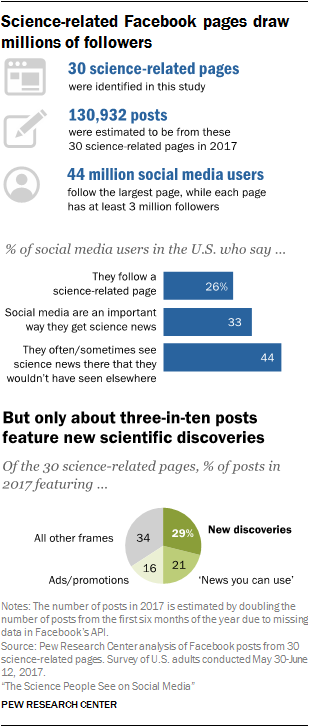A picture of fruit cups posted to Facebook in 2015, which has since generated over five million social interactions, signifies a new shift in how we receive and read our science news on Facebook, according to a new study from the Pew Research Center.
According to the study, science-related Facebook pages—that’s anything from Discovery’s Facebook page to the Facebook pages of prominent figures Bill Nye and Dr. Oz—are embracing three dominant categories defined by Pew researchers: new discoveries, “news you can use,” and promotional content to connect with Facebook audiences. (Think: “Top 10 Acupressure Points to Relieve Body Pains & Aches,” “How to Get Healthy & Shiny Hair Using Eggs and Avocado,” and a National Geographic photo-caption contest for a picture of monkeys.)

Analyzing 30 science-related Facebook pages, the researchers found that most of the pages specialized in one or two subject areas, as opposed to a range of topics for content. Across the 30 sites, 66 percent of the content in 2017 focused on either health, medicine, nutrition, animal science, astronomy, or physics. Twenty-one percent of the content spoke to “advice-oriented and self-help tips”; 16 percent were promotions-related, such as public figure appearances and content of other media. The study also found that several Facebook pages shared a significant number of posts that were not about science topics at all.
The Pew research offers a step toward understanding the demographic make-up and consumption patterns of Facebook users, in particular how they find science news in this age of quick content circulation. “As concerns about public understanding and acceptance of scientific evidence have increased over the past few years, this analysis provides a window into the sources of information,” the Pew researchers write.
Of the 30 included platforms, half were multi-platform sites with a Facebook page, or outside outlets that use Facebook as a platform to promote content, such as BBC Earth and Popular Science. The other 15 were Facebook-primary pages—that is, Facebook accounts connected to individuals or organizations with a large social media reach, but no corresponding offline outlet. Some Facebook-primary pages include figures such as Bill Nye and Neil deGrasse Tyson.

The research also showed that articles speaking about topics “at the center of public divisions,” such as climate change, genetically modified organisms, and vaccines, receive smaller amounts of attention on both Facebook-primary and multi-platform Facebook posts. Instead, the posts with highest engagement, specifically on Facebook-primary pages, covered the topic of research funding.





